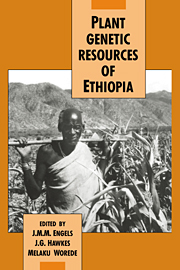Book contents
- Frontmatter
- Contents
- Contributors
- List of acronyms
- Preface
- Part I General introduction
- Part II The Ethiopian centre of diversity
- 2 The Ethiopian gene centre and its genetic diversity
- 3 Crops with wild relatives found in Ethiopia
- 4 Diversity of the Ethiopian flora
- 5 Forest genetic resources of Ethiopia
- 6 Plants as a primary source of drugs in the traditional health practices of Ethiopia
- 7 Traditional aromatic and perfume plants in central Ethiopia (a botanical and ethno-historical survey)
- 8 Spice germplasm in Ethiopia
- 9 A diversity study in Ethiopian barley
- 10 Sorghum history in relation to Ethiopia
- 11 Prehistoric Ethiopia and India: contacts through sorghum and millet genetic resources
- 12 Konso agriculture and its plant genetic resources
- Part III Germplasm collection and conservation in Ethiopia
- Part IV Evaluation and utilization of Ethiopian genetic resources
- Index
8 - Spice germplasm in Ethiopia
Published online by Cambridge University Press: 30 October 2009
- Frontmatter
- Contents
- Contributors
- List of acronyms
- Preface
- Part I General introduction
- Part II The Ethiopian centre of diversity
- 2 The Ethiopian gene centre and its genetic diversity
- 3 Crops with wild relatives found in Ethiopia
- 4 Diversity of the Ethiopian flora
- 5 Forest genetic resources of Ethiopia
- 6 Plants as a primary source of drugs in the traditional health practices of Ethiopia
- 7 Traditional aromatic and perfume plants in central Ethiopia (a botanical and ethno-historical survey)
- 8 Spice germplasm in Ethiopia
- 9 A diversity study in Ethiopian barley
- 10 Sorghum history in relation to Ethiopia
- 11 Prehistoric Ethiopia and India: contacts through sorghum and millet genetic resources
- 12 Konso agriculture and its plant genetic resources
- Part III Germplasm collection and conservation in Ethiopia
- Part IV Evaluation and utilization of Ethiopian genetic resources
- Index
Summary
Introduction
Although spices are considered as minor crops their significance for Ethiopia can hardly be overestimated. Spices are needed every day in considerable amounts for the preparation of the main dish of the day.
Most of the spices needed in Ethiopia are grown as field or garden crops, although some grow in the wild. Classical spices are also used but have to be imported, mainly from India. The following 12 spices, which originated in Ethiopia or were introduced very long ago and are considered to be of importance, are dealt with in this chapter:
Capsicum annuum (red pepper); Amh.: berbere
Trigonella foenum-graecum (fenugreek); Amh.: abish
Nigella sativa (black cumin); Amh.: tikur azmud
Trachyspermum ammi (Ethiopian caraway); Amh.: nech azmud
Coriandrum sativum (coriander); Amh.: dimbilal
Aframomum korarima (false cardamom); Amh.: korarima
Cuminum cyminum (cumin); Amh.: kamun
Foeniculum vulgare (fennel)
Pimpinella anisum (anise); Amh. for both: insilal
Ruta chalepensis (rue); Amh.: tena-addam
Ocimum basilicum (basil); Amh.: basobila
Piper longum (Indian long pepper); Amh.: timiz
Rhamnus prinoides (buckthorn); Amh.: gesho
Although ‘gesho’ is not a typical spice, it is included in this list, since it is of extreme importance in the flavouring of beverages during their preparation (Jansen, 1981).
In a broader sense, shallots (Allium cepa) and garlic (A. sativum) can be considered as spices.
- Type
- Chapter
- Information
- Plant Genetic Resources of Ethiopia , pp. 123 - 130Publisher: Cambridge University PressPrint publication year: 1991
- 2
- Cited by



